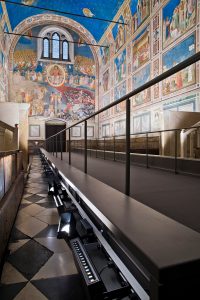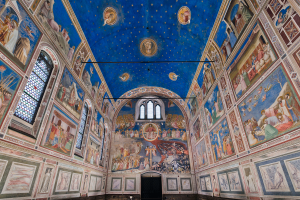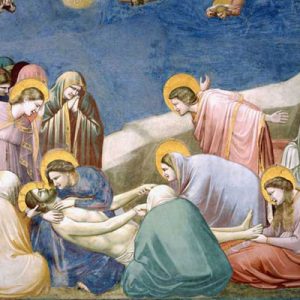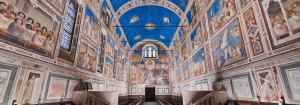Padua, city of art, in eight buildings and monumental complexes preserves pictorial cycles UNESCO heritage, since 2021, including the Scrovegni Chapel in Giotto and the frescoes of the Palazzo della Ragione: 3694 linear meters of frescoes handed over to history by the masters of the fourteenth century. The Scrovegni Chapel can be admired in just 15 minutes allowed to the visitor, where the gaze is lost in a spatial perspective with innovative colors concentrated in 900 square meters of surface painted by Giotto between 1303 and 1305. A nose up we immerse ourselves with our gaze in a sparkling blue (made from azurite, cheaper than lapis lazuli, as emerged from the 2000 restorations) of the backgrounds and of the sky set in the vault, on which more than four hundred golden stars shine, thanks to the innovative lighting system defined as “perceptive restoration ”Designed ad hoc by iGuzzini.
The lighting project for the Scrovegni Chapel allows the visitor to “touch with his eyes” the enchantment of the sky and in particular the reading of the “warm” shades (yellow-orange-red), enhancing the golden haloes inside, apart from the natural light that unites many scenes of the entire Giotto cycle.
Again, in this ad hoc lighting on a conservative level, there is the coherence of the iconographic conception with the sophisticated system, from the plinth to fake marbles where the Vices and Virtues are represented on monochrome backgrounds, up to the vault with the tondi dedicated to Evangelists and Doctors of the Church, in which narrative effects, gestures, postures and expressions of the painted subjects emerge.
After Cenacle from Leonardo da Vinci in Milan, this leading company from the Marche region, known internationally in the architectural lighting sector, founded in 1959, resumes its collaboration with the Municipality of Padua, under the supervision of the Interdisciplinary Scientific Commission for the Conservation and Management of the Scrovegni Chapel, in close collaboration with the Photometry Section of the Higher Institute for Conservation and Restoration, illuminating Giotto’s masterpiece with an innovative IoT system: “intelligent” lights improve the perception of space, light and color and guarantee energy savings of 60 %.

The system also leads to an immediate improvement of the already optimal conservation conditions, with a zeroing of UV and IR emissions to avoid the risk of damage to the painting cycle. The use of products with Tunable White technology allows you to dynamically adjust shades of white light as the intensity of natural light varies and ensures the optimal perception of the frescoes at all times of the day. Thus the figures have an even more real volume than those of Assisi, thanks to sensors designed to measure the variations of light, which adapts the emission levels of natural light and guarantees an excellent color rendering of the details that is part of a program of enhancement. architecture of the cultural heritage of Padua and energy efficiency of the city, which will also affect the astronomical observatory of the Specola and the Palazzo della Ragione with the installation of new lighting systems.
This dynamic system of light capable of adapting artificial light to changing environmental conditions, in the Scrovegni Chapel captures the meaning of the entire Giottesque cycle: salvation poised between solemnity and sacredness. And it is a symbolic meaning included in the light, starting from the apparition of God (above the arch of the apse) to the Last Judgment (on the opposite side).

The iconographic program is inspired by the doctrine of salvation through the relationship operated by Jesus, and is completed with the Last Judgment.
Each episode depicted in the bands is a self-referential work due to the compositional quality and naturalism typical of the Giottesque style. Among the other episodes we must not forget, the first kiss in the history of art between Joachim, warmly welcomed by Anna, in which the emotion of the meeting is evident even in the gaze and smile of the protagonists, and it is so different from the kiss of Judas to Christ: the gesture of betrayal, of a dramatic dynamism thanks to a blue background, fragmented by the stirring in the sky of spades, torches and lanterns.
Giotto’s surprising narrative spontaneity does not conform to the iconographic exceptions of the time, in which feelings prevail, naturalness without renouncing the narrative rhythm and under the light iGuzzini the emotions of the characters participating in the portrayed scenes leap to the eyes, such as pain, amazement, joy, despair, anticipation and spirituality.
Along the left side of the chapel, Giotto uses more space available to insert large decorative bands between the scenes, with small biblical episodes to be interpreted as a prefiguration of the evangelical facts. The prophet swallowed up and after three days emerged from the womb of the cetacean of impressive naturalism painted between the scenes of the Crucifixion and the Lamentation dead, in which iGuzzini’s layout allows you to enjoy the landscape not as a background, but an important element of Giotto’s composition and above all it “sets fire” to the golden halos of the saints. Surprising is San Giovanni, with his arms outstretched perpendicular to the image plane, which seems to “break through” the space. The entire counter-façade is dominated by the Last Judgment: blessed and damned, apostles and angelic hosts around Christ the judge seem like a scenography ready to be “rolled up” by the two angels at the top; the Kingdom of Heaven is about to take its place.

The lighting project allows an almost three-dimensional perception of the frescoes, it has become a model of a new approach of convergence between technology and conservative enhancement of our artistic heritage, it allows a fruition not only more emotional, but more truthful also on the formal and compositional level, allowing the vision of every single detail of the figures divided into bands on the walls.
The viewer’s gaze enters, as in a film without sound, into the stories of Giacchino and Anna and those of the Virgin (above) and of Jesus Christ (in the two bands below), to stop on the allegories painted at the base of the lateral parts , where seven vices and virtues that seem “sculpted” by light impress, in particular envy impresses almost a bas-relief inscribed in a marble light: an icon of yesterday and today.

